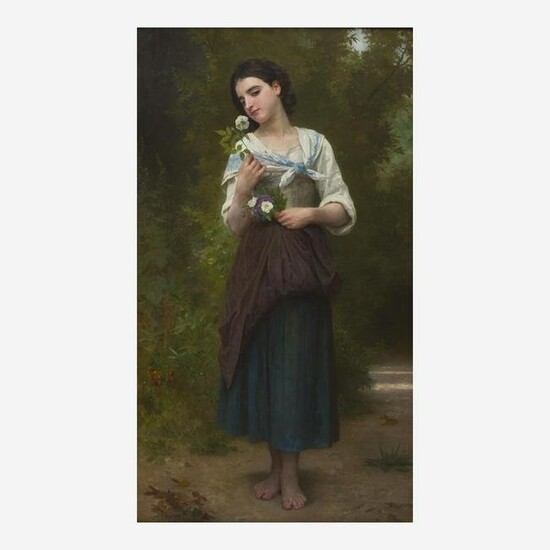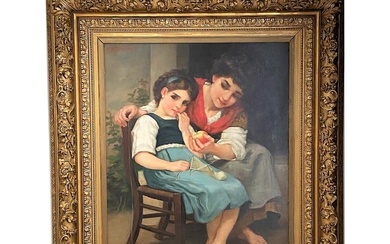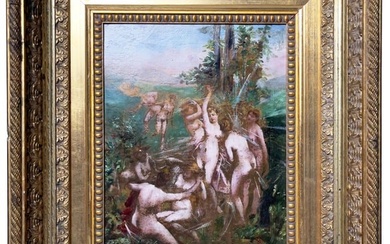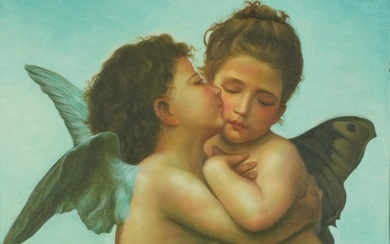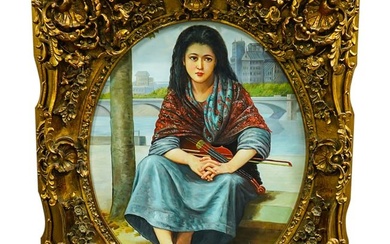William-Adolphe Bouguereau (French, 1825–1905) La Fleur Préférée (also known as
William-Adolphe Bouguereau (French, 1825–1905) La Fleur Préférée (also known as 'L'Odorat')
Signed and dated 'W-BOVGVEREAV-1895' bottom left, oil on canvas
62 3/8 x 36 in. (158.5 x 91.5cm)
Provenance
The Artist.
Acquired directly from the above.
Collection of Solomon Mehrbach, New York, New York.
A.A.A, New York, New York, sale of March 1, 1906, Lot 128 (as The Gardener's Daughter).
Acquired directly from the above sale.
Collection of Colonel Nathan H. Heft, Bridgeport, Connecticut.
A.A.A., New York, sale of January 22, 1920, Lot 72 (as The White Rose).
Acquired directly from the above sale.
Private Collection, New York.
A.A.A., New York, sale of November 17, 1938, Lot 64 (as The Wild Rose).
Acquired directly from the above sale.
Collection of Michael J. Kutza, USA.
Sotheby's, New York, sale of April 28, 1977, Lot 169 (as La Fille du Jardinier).
Acquired directly from the above sale.
Private Collection, North Carolina.
Exhibited
"North Carolina Collects: Traditional Fine Arts and Decorative Arts," Mint Museum of Art, Charlotte, North Carolina, July 9-September 18, 1994, no. 7 (as Peasant Girl).
Literature
William Bouguereau's Accounts, as L'odorat.
Amable Charles Franquet de Franqueville, "William Bouguereau" in Le Premier Siècle de l'Institut de France, Vol. I, J. Rothschild, Paris, 1895, p. 370 (as La Fleur).
Marius Vachon, W. Bouguereau, A. Lahure, Paris, 1900, p. 29 (as L'odorat).
Braun & Clément, Oeuvres Choisies des Maîtres Anciens et Modernes, Braun, Clément et Cie., New York, 1907, no. 5445 (illustrated as La Fleur Préférée).
Mark Steven Walker, William Bouguereau: A Summary Catalogue of the Paintings, New York, 1991, p. 74.
Damien Bartoli and Frederick C. Ross, William Bouguereau: Catalogue Raisonné of his Painted Work, Vol. II, Antique Collectors' Club , New York and Art Renewal Center, Woodbridge, NJ, 2010, no. 1895/12, pl. 225 (illustrated as La Fleur Préférée).
Note
The highly refined and polished art of William Bouguereau is often used as the quintessential illustration of 19th Century French Academism. His name is forever associated with images of elegant female sitters, mostly young girls and teens, as well as mythological figures, caught in a moment of grace, lightness, and sensuality, with an almost photographic quality. These artistic traits, which Bouguereau refined throughout his fifty-year-long-career, made him hugely successful, both academically and financially. It also enabled him to present and sell his work in the United States early on, as such academic finesse and gentle moralization appealed to conservative, often industrialist, collectors of the Gilded Age. At the time of Bouguereau’s death in 1905, The New York Times even concluded: “at one time to possess a Bouguereau was regarded as the first necessity for an art patron.”
Appearing at auction for the first time in over fifty years, the present work dates from the artist’s mature, experienced period, just ten years before his death. It was most likely a “tableau de vacances,” executed in the summer of 1895 while Bouguereau sojourned in his villa on rue Verdière in La Rochelle, and completed later that same year in the artist’s Parisian studio. Bouguereau repeatedly worked from live models and was known for hiring Italian teenagers in the region, whom he paid generously to gain their trust, so they would appear in later works. While the identity of our sitter remains a mystery, she was most likely a local Rochelaise, whose delicate treats and slender allure appealed to the master.
On many levels, La Fleur Préférée is a quintessential, textbook example of Bouguereau’s artistic mastery. In a lush landscape stands an almost life-size paysanne, unalarmed, her bare feet firmly planted in the dirt path on which she was walking before stumbling upon us. Simply dressed (she wears a traditional bodice and draped dress like many peasant girls of the time), she holds a small bouquet of wildflowers, from which she plucked a white rose -the titular favorite flower-which she languorously sniffs. Like many of Bouguereau’s earlier works, La Fleur Préférée stands as an idealized version of rustic life. Contrary to Jean-François Millet, Léon Lhermitte or Jules Breton who also depicted farmers and peasants, Bouguereau does not hint at the harsh conditions associated with the rural way of life. The young woman is beautiful, elegant (although her attire is simple, a rather sophisticated scarf is tied on her shoulders), and immaculate, as revealed by her pristine apron, and her clean hands and feet, which Bouguereau particularly excels at rendering here in a formidable foreshortening. According to Alfred Nettement, a student of the master at the Académie Julian in Paris, Bouguereau in fact had “absolute horror of what he would call realism and he always said that reality is charming when it borrows a gleam of poetry from imagination.”
Yet, the present work slightly differs from Bouguereau’s past depictions of young maidens, as it introduces a new sense of confrontation and directness which resembles the more provocative, modern works such as Jeune Bergère (1885), Jeune Bergère Debout (1887) and Petite Bergère (1891). This bold face à face is duplicitous. While at first glance one might see a young girl slightly intimidated by her encounter with the viewer, using the flower as a screen, a second read reveals a self-assured adolescent voluntarily engaging with us, assessing the male audience directly, with no hint of slyness, pruderie or reserve. The sitter projects self-assurance, and her heavy gaze implies coyness, flirting even, which somehow clashes with the so-called naïveté and innocence Bouguereau aimed at depicting in the French peasants he portrayed, and for which wealthy American collectors would pay large sums of money.
Here, the narrative is stronger than usual, as revealed by the successive changes of title in our painting’s history, subtly implying that each of its owner preferred a different facet of the story. The bouquet the girl holds in her hands may have been assembled by her, as she wandered through the woods along the dirt path. In this version, Bouguereau would have depicted a moment suspended in time; a halt during which “the gardener’s daughter” picked her favorite flower to smell its intoxicating perfume before returning home, or to work. But the flowers could also have been collected by someone else. The bouquet may be a gift from a young aspiring lover, anonymous and unseen, which would explain our model’s smitten expression, her demure pose. The rose, a traditional symbol of love, hints at the sitter’s true story. Its color white reassures the viewer however: the suitor’s love is pure, gentle and evidently sincere. The seemingly innocuous presence of scattered autumn leaves at the girl’s feet, to the left, could also feed this romantic lecture, and imply not only the passage of time, but the transition from the age of innocence to puberty. By removing the male figure, and only implying his role through the proxy of the flower, Bouguereau acts subtly, and protects the female character from compromising herself. He sublimizes the representation of true love, desire and longing. In a certain way, he offers a new (rural) vision of fine amor, by which the woman is the true center of attention, the object of veneration for whom the man will surpass himself to prove his good intentions.
By offering multiple interpretations, the work gains in ambivalence and strength. It also reveals Bouguereau’s playfulness, and the looser, more versatile connotations associated with his later production, which he did not have to submit to any institution, gallerist or patron as he freely embraced fame and success. In many ways, it shows Bouguereau’s attempt at modernism, which he expressed more subtly than Impressionists Claude Monet or Pierre-Auguste Renoir who worked in direct reaction against his work by deliberately depicting mundane subjects in a broken brushwork and a bold palette, miles away from Bouguereau’s impeccable style, smooth, almost imperceptible, brushwork, and rich surface details replete with harmonious colors.
By the time he completed the present work, genre painting made up more than a third of William Bouguereau’s total production. He enjoyed depicting local peasant girls, and did so frequently in large part because he could sell the finished canvases more rapidly than his large history paintings, especially through his motivated dealers, Goupil and Durand-Ruel himself. There was no exception in the case of La Fleur Préférée, which was bought directly from the artist by Solomon Mehrbach of New York City, and has remained in the United States ever since. Mehrbach’s background was similar to many collectors of Bouguereau. His recent wealth, which he gained through the railway development, as well as his presence in one of the most urbanized centers of the Western world, pushed him to view Bouguereau’s pastoral portraits with curiosity, fascination and probably envy to what he likely perceived to be an honest, noble, and more gratifying way of life.
To request a condition report, or for any additional information, please email Raphael Chatroux at rchatroux@freemansauction.com.
Sale price
Estimate
Time, Location
Auction House
William-Adolphe Bouguereau (French, 1825–1905) La Fleur Préférée (also known as 'L'Odorat')
Signed and dated 'W-BOVGVEREAV-1895' bottom left, oil on canvas
62 3/8 x 36 in. (158.5 x 91.5cm)
Provenance
The Artist.
Acquired directly from the above.
Collection of Solomon Mehrbach, New York, New York.
A.A.A, New York, New York, sale of March 1, 1906, Lot 128 (as The Gardener's Daughter).
Acquired directly from the above sale.
Collection of Colonel Nathan H. Heft, Bridgeport, Connecticut.
A.A.A., New York, sale of January 22, 1920, Lot 72 (as The White Rose).
Acquired directly from the above sale.
Private Collection, New York.
A.A.A., New York, sale of November 17, 1938, Lot 64 (as The Wild Rose).
Acquired directly from the above sale.
Collection of Michael J. Kutza, USA.
Sotheby's, New York, sale of April 28, 1977, Lot 169 (as La Fille du Jardinier).
Acquired directly from the above sale.
Private Collection, North Carolina.
Exhibited
"North Carolina Collects: Traditional Fine Arts and Decorative Arts," Mint Museum of Art, Charlotte, North Carolina, July 9-September 18, 1994, no. 7 (as Peasant Girl).
Literature
William Bouguereau's Accounts, as L'odorat.
Amable Charles Franquet de Franqueville, "William Bouguereau" in Le Premier Siècle de l'Institut de France, Vol. I, J. Rothschild, Paris, 1895, p. 370 (as La Fleur).
Marius Vachon, W. Bouguereau, A. Lahure, Paris, 1900, p. 29 (as L'odorat).
Braun & Clément, Oeuvres Choisies des Maîtres Anciens et Modernes, Braun, Clément et Cie., New York, 1907, no. 5445 (illustrated as La Fleur Préférée).
Mark Steven Walker, William Bouguereau: A Summary Catalogue of the Paintings, New York, 1991, p. 74.
Damien Bartoli and Frederick C. Ross, William Bouguereau: Catalogue Raisonné of his Painted Work, Vol. II, Antique Collectors' Club , New York and Art Renewal Center, Woodbridge, NJ, 2010, no. 1895/12, pl. 225 (illustrated as La Fleur Préférée).
Note
The highly refined and polished art of William Bouguereau is often used as the quintessential illustration of 19th Century French Academism. His name is forever associated with images of elegant female sitters, mostly young girls and teens, as well as mythological figures, caught in a moment of grace, lightness, and sensuality, with an almost photographic quality. These artistic traits, which Bouguereau refined throughout his fifty-year-long-career, made him hugely successful, both academically and financially. It also enabled him to present and sell his work in the United States early on, as such academic finesse and gentle moralization appealed to conservative, often industrialist, collectors of the Gilded Age. At the time of Bouguereau’s death in 1905, The New York Times even concluded: “at one time to possess a Bouguereau was regarded as the first necessity for an art patron.”
Appearing at auction for the first time in over fifty years, the present work dates from the artist’s mature, experienced period, just ten years before his death. It was most likely a “tableau de vacances,” executed in the summer of 1895 while Bouguereau sojourned in his villa on rue Verdière in La Rochelle, and completed later that same year in the artist’s Parisian studio. Bouguereau repeatedly worked from live models and was known for hiring Italian teenagers in the region, whom he paid generously to gain their trust, so they would appear in later works. While the identity of our sitter remains a mystery, she was most likely a local Rochelaise, whose delicate treats and slender allure appealed to the master.
On many levels, La Fleur Préférée is a quintessential, textbook example of Bouguereau’s artistic mastery. In a lush landscape stands an almost life-size paysanne, unalarmed, her bare feet firmly planted in the dirt path on which she was walking before stumbling upon us. Simply dressed (she wears a traditional bodice and draped dress like many peasant girls of the time), she holds a small bouquet of wildflowers, from which she plucked a white rose -the titular favorite flower-which she languorously sniffs. Like many of Bouguereau’s earlier works, La Fleur Préférée stands as an idealized version of rustic life. Contrary to Jean-François Millet, Léon Lhermitte or Jules Breton who also depicted farmers and peasants, Bouguereau does not hint at the harsh conditions associated with the rural way of life. The young woman is beautiful, elegant (although her attire is simple, a rather sophisticated scarf is tied on her shoulders), and immaculate, as revealed by her pristine apron, and her clean hands and feet, which Bouguereau particularly excels at rendering here in a formidable foreshortening. According to Alfred Nettement, a student of the master at the Académie Julian in Paris, Bouguereau in fact had “absolute horror of what he would call realism and he always said that reality is charming when it borrows a gleam of poetry from imagination.”
Yet, the present work slightly differs from Bouguereau’s past depictions of young maidens, as it introduces a new sense of confrontation and directness which resembles the more provocative, modern works such as Jeune Bergère (1885), Jeune Bergère Debout (1887) and Petite Bergère (1891). This bold face à face is duplicitous. While at first glance one might see a young girl slightly intimidated by her encounter with the viewer, using the flower as a screen, a second read reveals a self-assured adolescent voluntarily engaging with us, assessing the male audience directly, with no hint of slyness, pruderie or reserve. The sitter projects self-assurance, and her heavy gaze implies coyness, flirting even, which somehow clashes with the so-called naïveté and innocence Bouguereau aimed at depicting in the French peasants he portrayed, and for which wealthy American collectors would pay large sums of money.
Here, the narrative is stronger than usual, as revealed by the successive changes of title in our painting’s history, subtly implying that each of its owner preferred a different facet of the story. The bouquet the girl holds in her hands may have been assembled by her, as she wandered through the woods along the dirt path. In this version, Bouguereau would have depicted a moment suspended in time; a halt during which “the gardener’s daughter” picked her favorite flower to smell its intoxicating perfume before returning home, or to work. But the flowers could also have been collected by someone else. The bouquet may be a gift from a young aspiring lover, anonymous and unseen, which would explain our model’s smitten expression, her demure pose. The rose, a traditional symbol of love, hints at the sitter’s true story. Its color white reassures the viewer however: the suitor’s love is pure, gentle and evidently sincere. The seemingly innocuous presence of scattered autumn leaves at the girl’s feet, to the left, could also feed this romantic lecture, and imply not only the passage of time, but the transition from the age of innocence to puberty. By removing the male figure, and only implying his role through the proxy of the flower, Bouguereau acts subtly, and protects the female character from compromising herself. He sublimizes the representation of true love, desire and longing. In a certain way, he offers a new (rural) vision of fine amor, by which the woman is the true center of attention, the object of veneration for whom the man will surpass himself to prove his good intentions.
By offering multiple interpretations, the work gains in ambivalence and strength. It also reveals Bouguereau’s playfulness, and the looser, more versatile connotations associated with his later production, which he did not have to submit to any institution, gallerist or patron as he freely embraced fame and success. In many ways, it shows Bouguereau’s attempt at modernism, which he expressed more subtly than Impressionists Claude Monet or Pierre-Auguste Renoir who worked in direct reaction against his work by deliberately depicting mundane subjects in a broken brushwork and a bold palette, miles away from Bouguereau’s impeccable style, smooth, almost imperceptible, brushwork, and rich surface details replete with harmonious colors.
By the time he completed the present work, genre painting made up more than a third of William Bouguereau’s total production. He enjoyed depicting local peasant girls, and did so frequently in large part because he could sell the finished canvases more rapidly than his large history paintings, especially through his motivated dealers, Goupil and Durand-Ruel himself. There was no exception in the case of La Fleur Préférée, which was bought directly from the artist by Solomon Mehrbach of New York City, and has remained in the United States ever since. Mehrbach’s background was similar to many collectors of Bouguereau. His recent wealth, which he gained through the railway development, as well as his presence in one of the most urbanized centers of the Western world, pushed him to view Bouguereau’s pastoral portraits with curiosity, fascination and probably envy to what he likely perceived to be an honest, noble, and more gratifying way of life.
To request a condition report, or for any additional information, please email Raphael Chatroux at rchatroux@freemansauction.com.
